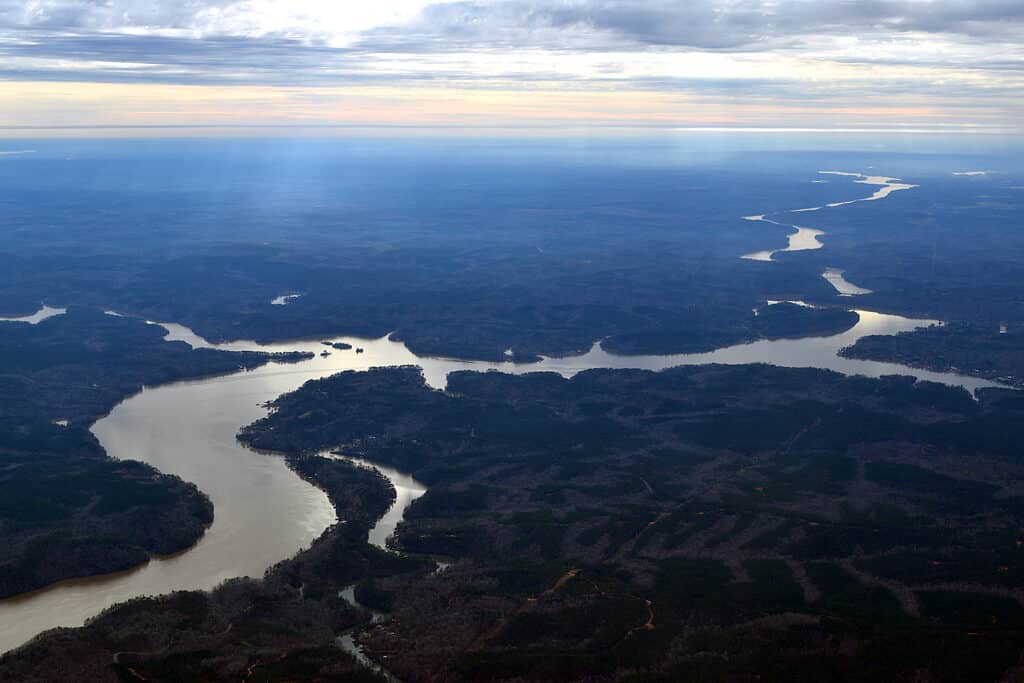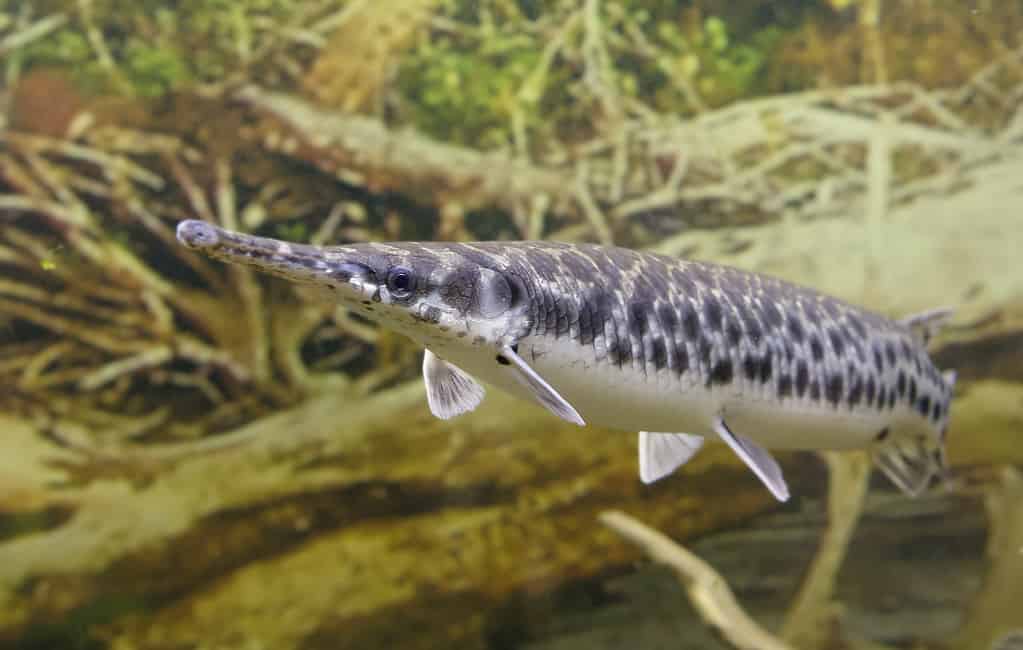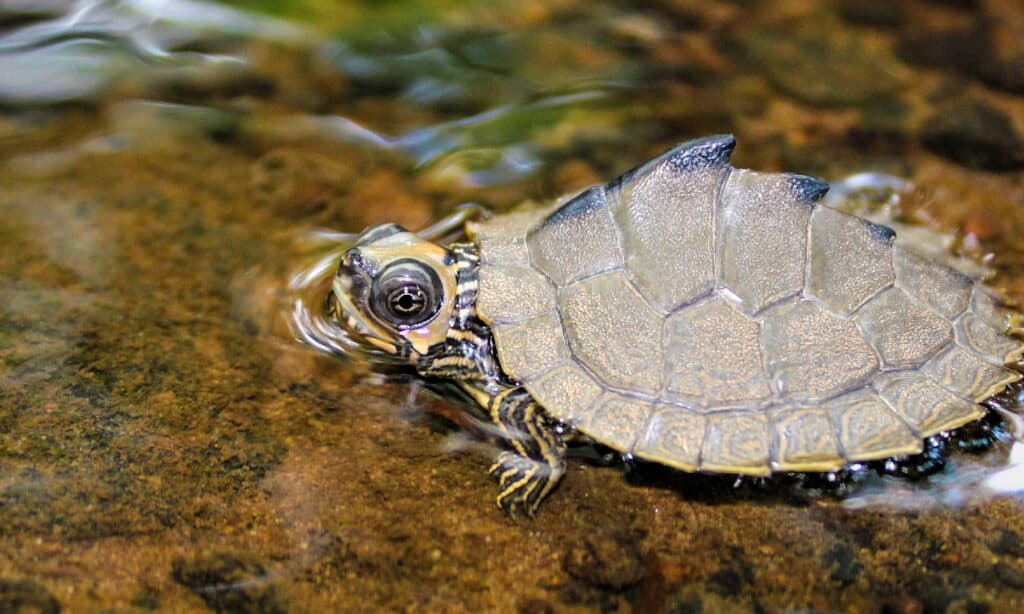Interested in the ecosystem and overall health of the Coosa River? This crucial, highly biodiverse waterway in Alabama is currently threatened by immense pollution. Environmental groups are working hard to protect this river for all the lifeforms who depend upon it.
In this guide, we’ll provide an overview of what’s in the Coosa River, both lifeforms and pollution, and offer our informed opinion on the safety of swimming in this river.
Overview of the Coosa River
Beginning at the confluence of the Oostanaula and Etowah Rivers in Rome, Georgia, the Coosa River flows southwest into eastern Alabama and continues southward until it meets the Alabama River just north of Montgomery. Over 90% of this 280-mile-long river exists in Alabama. The Coosa River ranges from 300-500 feet across.
Climate and Geography
The surrounding climate of the Coosa River is humid subtropical. The average annual temperature of the region is about 64 degrees Fahrenheit. On exceedingly rare occasions, parts of the Coosa River have briefly frozen during the winter. But generally, you can expect this river to remain unfrozen in the cold months.
The lands bordering the upper portion of the Coosa River are characterized by gently hilly terrain consisting of mixed hardwood and conifer forests. As the river makes its way further south into central Alabama, the landscape becomes flatter and features large swathes of pine and oak forests.

The Coosa River meanders its 280-mile path into central Alabama, where it meets the Alabama River.
©Tracy Burroughs Brown/Shutterstock.com
What’s in the Coosa River: Pollution Threats
Sadly, portions of the Coosa River are heavily polluted. It is listed as the fifth most polluted river in the U.S. by the river conservation organization, American Rivers.
About 95% of the nearly one million pounds of chemical waste dumped in the river each year comes from the poultry industry. Specifically, the environmental organization Coosa Riverkeeper names the Koch Foods of Gadsden Chicken Processing and the JCG Foods of Alabama Chicken Processing plants as the predominant sources of excess nitrate pollution in the Coosa River. Excess nitrogen in the Coosa River can cause large algae blooms. These blooms can release algal toxins into the water, threatening the health of aquatic animals and people alike.
The remaining 5% of the pollutants are highly toxic chemicals. They are released primarily by the Gaston Steam Plant and the Resolute Forest Products Coosa Pines paper mill. The chemicals released by these plants are known to be developmental, carcinogenic, and reproductive toxins. Additionally, E. coli contamination from stormwater runoff and spills pollute various parts of the river, periodically rendering areas unsafe for swimming.
According to a report by American Rivers, the pollution of the Coosa River represents a threat to the drinking water supply and the overall health of the ecosystem.
Animals of the Coosa River
The Coosa River is home to a high level of geological and biological diversity. The ecosystem of this river is quite special. Unfortunately, it has been impacted not only by pollution but other destructive aspects of human civilization. According to the Center for Biological Diversity, the construction of dams on the Coosa River has directly led to the extinction of 36 aquatic species. Environmental groups have been working for years to protect the remaining species of the river. They push for stricter environmental regulations, monitor water quality, aid in restoration, and work to remove antiquated dams that obstruct flows from creeks into the river.
While heavy industrial pollution and dam construction threaten the ecosystem of the Coosa River, animals still manage to make homes for themselves in the water, along the banks, and among the surrounding woodlands bordering this crucial waterway. Below, we’ll learn about four species of animals that call the Coosa home.
Longnose Gar (Lepisosteus osseus)
The longnose gar (Lepisosteus osseus) is a prehistoric beauty. Members of the gar family, Lepisosteidae, have likely existed in North American waters for over 100 million years. These highly adaptable fish can live in fresh and brackish waters. They widely occur in waterways throughout the eastern and southwest U.S., including the Coosa River.
The longnose gar features an elongated body and a narrow, long snout that measures twice the length of its head. This apex predator can grow to over 6.5 feet and thick, overlapping, armor-like scales protect it. Thanks to their highly vascularized swim bladder, the longnose gar can intake oxygen through the air in very low oxygen and high salinity waters. In the right conditions, the longnose gar can live up to about 20 years.
These fortified predators eat a variety of prey, including crustaceans, fish, and mollusks. As juveniles, the diet of the longnose gar consists primarily of insects and crustaceans. Once they reach adulthood, they prefer to hunt fish. When hunting, they use ambush tactics, lying motionless in the water until an unsuspecting meal swims too close to its long jaws.

The longnose gar is an apex predator of the Coosa River.
©iStock.com/User10095428_393
What’s in the Coosa River: Alabama Map Turtle (Graptemys pulchra)
The Alabama map turtle (Graptemys pulchra) is a medium to large-sized aquatic turtle endemic to the southern U.S. The International Union for Conservation of Nature (IUCN) lists the Alabama map turtle as near threatened. The state of Alabama lists this turtle as a protected species. Habitat destruction and degradation through development and pollution are the largest threats to this species.
You can recognize turtles in the Graptemys genus by the dorsal keels on their shell. A keel is a ridge that runs down the middle of a scale. On juvenile Alabama map turtles, the dorsal keels are spiny and distinct. As they age, these projections often wear down. Adults tend to feature a slightly raised ridge on the dorsal section of their shell.
Their range occurs throughout the Mobile Bay drainage basin, which includes a large portion of the Coosa River. Adult males and juveniles feed mostly on aquatic insects. Adult females have much more powerful jaws that allow them to feed on mollusks.

As juveniles, the Alabama map turtle has a distinct, spiny ridge running along the dorsal section of its shell.
©iStock.com/Tucker Heptinstall
Coosa Moccasinshell Mussel (Medionidus parvulus)
The Coosa moccasinshell mussel (Medionidus parvulus) is one of 8 species of endangered freshwater mussels living in the Coosa River. These crucial animals are often called “ecosystem engineers” by biologists due to their critical role in filtering bacteria, algae, and contaminants from the water. The construction of dams and years of pollution and sediment buildup from industrial and agricultural waste are currently threatening the Coosa moccasin shell mussel.
The shell of this mussel is thin and fragile. The outermost layer of the elongated shell (periostracum) is yellow-brown to dark brown and features thin green rays. The innermost, protective layer of the Coosa moccasinshell mussel (called a nacre) is a light, shiny blue. They feed by filtering small organic particles, predominantly bacteria, and algae, out of the water column and into their gill chambers.
What’s in the Coosa River: Coosa Darter (Etheostoma coosae)
The Coosa darter (Etheostoma coosae) is endemic to the Coosa River watershed. This small species of freshwater ray-finned fish currently enjoys a healthy population and extensive range throughout the Coosa River watershed in Alabama, Tennessee, and Georgia. However, without continued advocacy to protect and restore this crucial river system, the Coosa darter may not remain secure.
Adult Coosa darters average about 1.5 inches in length. The preferred habitat of this little darter includes shallow areas of waterways around boulders, near sandbars, and in rocky pools below shallow but fast-moving water. The diet of the Coosa darter includes microcrustaceans, mayfly larvae, aquatic plant material, water mites, and midge larvae. They primarily spawn from mid-March through mid-May. Their lifespan is 3-4 years.

The Coosa darter is endemic to the Coosa River watershed.
©John P. Friel CC BY 4.0 – License
What’s in the Coosa River: Is It Safe to Swim?
Ultimately, the largest safety concern for swimmers in the Coosa River is the pollution levels in this waterway. Not only are there high excesses of nitrate waste and E. coli found in the Coosa, but there are also cancer-causing, reproductive, and developmental toxins present as well from industrial waste.
For swimmers, the best course of action is to avoid any areas with algae blooms. Monitor sites such as the Coosa Riverkeeper and Coosa River Basin Initiative for reports on E. coli contamination in various sections of the river. Year-round, it’s important to not swallow water while swimming.
The photo featured at the top of this post is © iStock.com/Shackleford-Photography
Thank you for reading! Have some feedback for us? Contact the AZ Animals editorial team.






